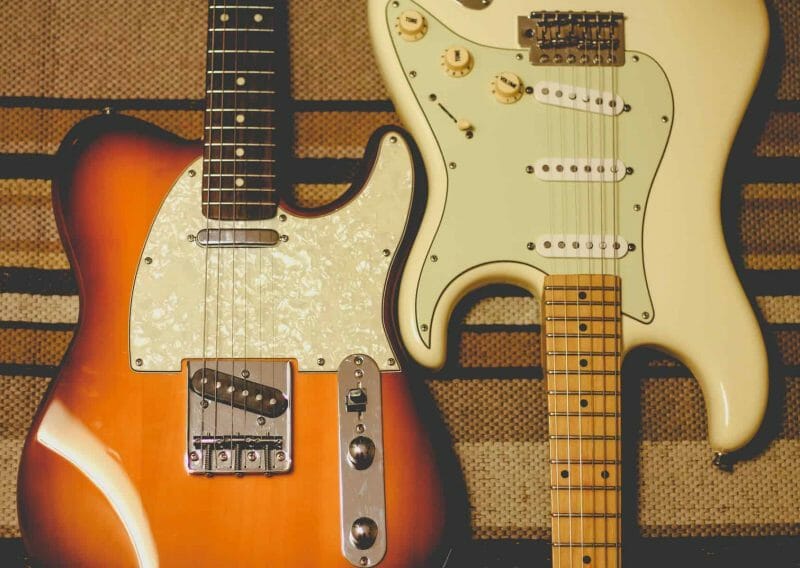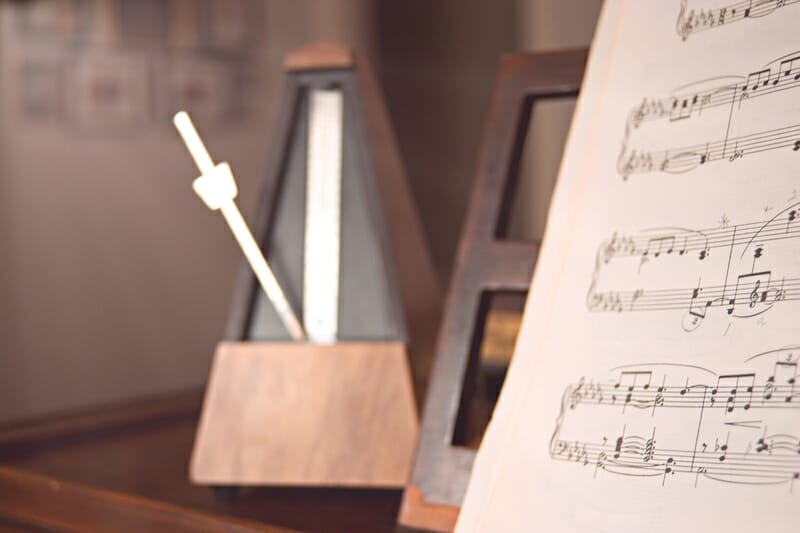“Just give up playing the guitar!”
That’s your internal critic. You will face him at some point.
Every guitarist goes through this stage (AKA “the hump”). But if you approach playing the guitar the right way, you can turn the volume down on your internal critic.
Is it hard to play the guitar? Well, it’s hard to learn, but you can make it easier on yourself.
I’ve been playing since 2002, and these are the things I’ve learned about how to play guitar efficiently.
Know the parts of a guitar

Learning the main parts of the guitar is easy, thanks to the familiar terminology we use. We’ll use an acoustic guitar as an example.
If you stand the guitar up, you can imagine it like a person.
The big, curvy part is the body. The long section attached to that is the neck. And the rectangular top is called the head (also called the headstock).
The rest of the parts don’t fit into the “imagine it like a person” metaphor. But a lot of the names are obvious.
The little knobs on the headstock are tuners (they tune the strings).
The white bar located where the headstock and neck meet is called the nut. Each string has a corresponding nut groove.
The front side of the neck is called the fretboard, and the space in between each piece of metal are the frets.
Down on the body of the guitar, we have the bridge, which is where the strings attach. The elevated (usually white) part that sits on top of the bridge is called the saddle. The saddle mirrors the nut in that there’s a groove for each of the strings.
Speaking of strings, let’s learn them. When refering to the string notes, start with the thickest string (the 6th string) and go to the thinnest string (the 1st string):
E – A – D – G – B – e
To easily remember the notes of each string, you can use an acronym. Here are a few I’ve heard:
- Every American Digs Good Breakfast Eggs
- Elephants And Donkeys Grow Big Ears
- Every Amateur Does Get Better Eventually
Or make up your own! Whatever it takes to help you remember the notes of each string in standard tuning.
Learn to read chord charts and tabs
The next thing you must learn is how to read chord charts. These teach you how to play songs by telling you the exact way to play a chord (because you can play each chord in many different ways).
Here’s how you read chord charts…
When you look at a chord on a chord chart, your perspective is as if you’re looking at the guitar:
- Standing up, OR
- Tipped on its side to your left (the thinnest string is on the top)
A chord diagram shows you what string you press and on what fret.
When a string has no finger on it, you’ll see an X (don’t play the string) or an O (play the string open) where the string meets the nut.
Here’s what a G major looks like on a chord chart:

It’s also important to be familiar with how to write chords as a guitar tab. Rather than using an image like you would with a chord chart, tabs are a way to type or write how to play a chord.
You’d tab a G major chord like this:
E | 3
A | 2
D | o
G | o
B | o
e | 3
The number tells you on what fret to place your finger.
Easy chords for beginners
Now you can get started with your first chords. Here are some easy chords for beginners:
- G major
- D major
- C major 2 (C maj2)
- E minor (Em)
- A minor (Am)
Here’s how to play each of these (other than G major because we already covered that):
D major:
E | x
A | x
D | o
G | 2
B | 3
e | 2
Cmaj2:
E | x
A | 3
D | 2
G | o
B | 3
e | 3
Em:
E | o
A | 2
D | 2
G | o
B | o
e | o
Am:
E | x
A | o
D | 2
G | 2
B | 1
e | o
Strumming and rhythm
The thing that separates the average guitarist from a great guitarist is strumming and rhythm. It’s the X factor.
Any guitarist can play a G chord. But only a really good guitarist can play a G chord — you know, with emotion and soul. Your strumming technique and your ability to pick up on rhythm will convey emotion and keep people interested.
So let me give you an intro to strumming well and keeping rhythm.
Strumming basics
A down strum (from big E to little e) looks like ↓ and an up strum (from little e to big E) looks like ↑. These arrows are matched with each beat in the measure (1, 2, 3, 4).
So a good strumming pattern for beginners is:
1 – 2 – 3 – 4
↓ – ↑ – ↓ – ↑
Once you get that one down, try this strumming pattern:
1 – 2 – 3 – 4
↓ – x – ↑ – ↑
Here are some general strumming tips to know before you begin (assuming you’re a right-handed person on a right-handed guitar):
- When holding the guitar on your lap, your right elbow rests on the corner where the body and top side of the guitar meet
- Hold the pick at a slight angle up toward yourself
- Strum the strings directly over the soundhole
- Make sure you hit each string as shown on the chord diagram you’re reading
- Keep your wrist loosey-goosey — a rigid wrist makes it harder to finesse the strings
- Don’t only move your wrist — your elbow should be moving with each strum
- Each strum needs to have a different level of strength
The only thing left to do is practice, listen to how other artists strum, and practice more.
Practice your rhythm
You can’t have good strumming without good rhythm. So it’s a smart idea to do some rhythm exercises.
The easiest way to practice your rhythm is to jam along to your favorite songs. Slap your thighs, tap the table, or clap to the beat. And you can practice this anywhere at any time.
This will build your sense of rhythm, which will help your strumming dramatically.
Methods for teaching yourself guitar
Because you’re reading this post, you’re probably a self-starter. Which means you may be asking, “How can I teach myself to play guitar?”
Here are some helpful tips…
Play along with a song
This is the best way to learn guitar. Instead of learning scales and random chord progressions, pick a song you love and slowly learn it.
You’ll have more motivation to keep going. And the reward will be so much more satisfying.
What are the easiest songs to play on guitar for beginners?
Here are a few to get you started:
- “Love Me Do” by The Beatles
- “Let Her Go” by Passenger
- “Three Little Birds” by Bob Marley
- “Love Yourself” by Justin Bieber
- “Ocean Eyes” by Billie Eilish
Start slow
I know, you want to be great at guitar right now. But it takes time. It’s totally worth it, but it will take time.
Because of that, it’s tempting to try to play along with the song right off the bat. But don’t do that. You’ll just get frustrated.
You need to start slow.
Once you know the chords and how the song goes, play at your own pace. It may feel awkward to play the song slower than you hear it in your head, but it will help ease you into guitar playing.
This helps you build muscle memory, learn the strumming pattern, and gradually increase your chord-switching speed.
Use a metronome

Once you find a tempo that works for your skill level (whether it’s the song’s actual tempo or slower), play along to a metronome.
This strengthens your rhythm and helps you keep time the whole way through the song.
If you have a physical metronome, great. If not, try one of these apps:
Record yourself
You are not subjective. That’s why you need to record yourself — to be as objective as possible.
When you hear yourself playing guitar, you become the listener, no longer the player.
Try this: record yourself playing whatever chord progression or song you know. Then don’t listen to it until a day or two has passed. You’ll have fresh ears and a more objective mindset.
Tools for playing guitar
To successfully learn how to play the guitar, you need the right tools. Here are some of my favorites…
ChordFind.com
I’ve been playing guitar since 2002 and I still use ChordFind occasionally. It’s the simplest and quickest way to find the chord you need.
You can either pick the chord from a list, or you can do a reverse lookup where you enter the finger placement. Then it tells you the name of the chord.
When I was learning guitar, this site was a game-changer.
Ultimate Guitar
Ultimate-Guitar.com is perfect for both beginners and more advanced players. You can find chord progressions as well as detailed tabs with solos and riffs.
Users can add their own “tab” — what they think the chords are to a song. Then other people rank those tabs, so the most accurate rise to the top of searches.
There are also “official” tabs that include a video of someone playing the song so you can watch how to play it.
And it’s a library that keeps growing.
Physical chord chart
When I was learning guitar, I also had a physical chord chart hanging on my wall. Here’s why it was helpful…
I’d be in my bedroom playing a song. Then I’d forget how to play the next chord. Instead of going downstairs to the family desktop computer (remember those?), I could lift my head and look at the chart on my wall.
Phones have made chord lookups much easier, but looking at your wall is still way quicker than pulling out your phone.
A guitar video game
If you’re a gamer, you may want to check out video games that teach you how to play guitar. There are a ton of educational guitar games, but two of the best are JamPlay and Rocksmith.
I never got into learning guitar from games, but this could help you.
Conclusion
I hope you see you can learn the guitar on your own. As long as you have the drive, you have the tools available to become a great guitarist.
The key is to take it in small steps and be patient. It won’t be long before you’re making great music on the guitar.










